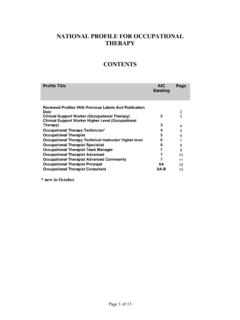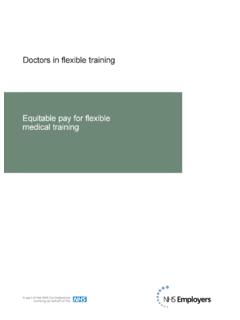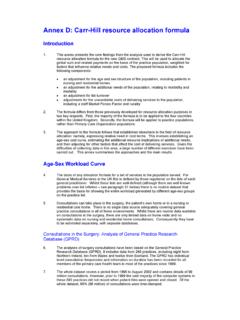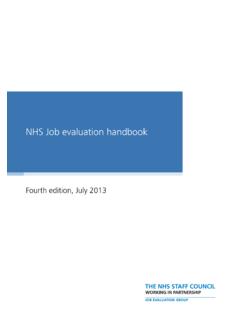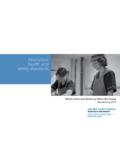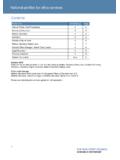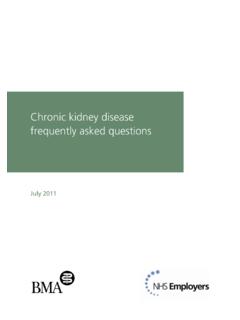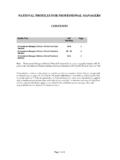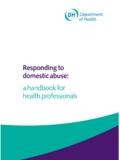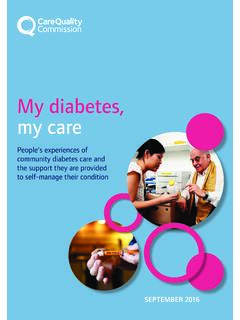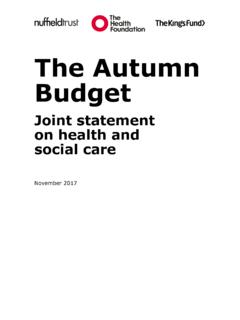Transcription of Identification and management of patients with …
1 Page 1 of 4 Identification and management of patients with frailty Summary of requirements Introduction From 1 July 2017, the general Medical Services (GMS) contract will require practices to routinely identify moderate and severe frailty in patients aged 65 years and over. Similar requirements will be made of PMS and APMS contract holders. The Five year forward view1 notes that support for older people living with frailty , along with mental health and cancer, is one of the three areas where the NHS faces particular challenges . frailty has been described as the most problematic expression of population ageing, in part because it can be difficult to distinguish those living with frailty from those without frailty . The introduction of routine Identification of frailty will help general practice address this and provide an opportunity to target and tailor appropriate care and support for older people with the greatest need. Moving from opportunistic to systematic population based Identification of frailty can help reduce inequalities, improve access to care and enable the needs of individuals to be met though early, proactive targeted and appropriate interventions.
2 Not all older people are frail and not all people living with frailty are old. However it is important to identify older people who are living with frailty to help stratify populations by risk of future health and care use. This will ensure that health and other preventative or supportive interventions are appropriately organised and targeted. Requirements Practices will be required to use an appropriate tool, for example the Electronic frailty Index (eFI), to identify patients aged 65 and over who are living with moderate or severe frailty . For those patients identified as living with severe frailty , the diagnosis must be recorded in the patient s record. For those patients identified by the tool as living with moderate frailty , clinical judgement will be required to determine whether that diagnosis is appropriate. If the GP agrees that the patient has moderate frailty , the result should be recorded in the patient record. For those patients identified as living with severe frailty , practices will be required to: deliver a clinical review, including providing an annual medication review and where clinically appropriate discuss whether the patient has fallen in the last 12 months, and 1 NHS England.
3 Five year forward view. Page 2 of 4 provide any other clinically relevant interventions, and explain the benefits of the enriched Summary Care Record (SCR), seeking informed patient consent to activate it. Practices will code clinical interventions for this group appropriately. Data will be collected on: the number of patients recorded with a diagnosis of moderate frailty . the number of patients recorded with a diagnosis of severe frailty . the number of patients with severe frailty with a record of an annual medication review. the number of patients with severe frailty who are recorded as having had a fall in the preceding 12 months. the number of patients with severe frailty who provided explicit consent to activate their enriched SCR. If the patient has reported a fall, there are a number of clinical interventions practices may wish to consider as clinically appropriate. Practices would routinely record clinical intervention, for example this could be for referrals to a falls2 clinic.
4 NHS England will use this information to understand the nature of the interventions made and the prevalence of frailty by degree among practice populations and nationally. This information will be used to identify patient and commissioning need to support practices in the management of frailty . The data will not be used for performance management or benchmarking purposes. Electronic frailty Index (eFI) information and FAQs Why use the eFI? The eFI has been externally validated, is widely available (from April will be available in 99 per cent of practices ie those using EMISweb, SystmOne or Vision) and uses existing primary care data from the health record so requires no further data collection. The development of the eFI is outlined in a paper published in 2016 on the Development and Validation of an electronic frailty Index using routine primary care electronic health record data 3. This describes how the eFI has been developed and validated using data from over 900,000 UK primary care patients .
5 The key points from the paper are: International guidelines recommend routine Identification of frailty . Other currently available tools require additional resource and may be inaccurate. The eFI has been developed and validated using routine primary care data. It can 2 Data will be collected on the number of referrals to falls clinics. This is not a contractual requirement. The data will be used by NHS England to inform need for falls clinics and improve commissioning of these services where necessary. 3 Oxford academic. Page 3 of 4 be automatically populated with routinely collected primary care Electronic Health Record (EHR) data The eFI has robust predictive validity for outcomes of nursing home admission, hospitalisation and mortality. Routine implementation of the eFI could: o enable better targeting of evidence-based interventions, o improve planning of health services utilisation, and o Facilitate the development of more appropriate, proactive, goal- orientated care for older people with frailty .
6 In addition, use of the eFI is supported in the NICE 2016 clinical guideline on multi-morbidity4. Does the eFI tool provide a score for all patients , or does the GP need to review and add the outcome after the score? The eFI has been validated using routinely available primary care electronic health record data using large internal and external validation cohorts. The GP (or another appropriate clinician) needs to review the results of the eFI before this is recorded. Like any tool, the eFI is not 100 per cent sensitive or specific so the subsequent clinical review of the score helps to prevent false negatives and false positives. Is the eFI tool automated? Yes. The tool can be used in an automated way using existing data in the patient record. Some reports suggest the available tools are not sensitive to identify people with moderate or lesser degrees of frailty . Does this include the eFI? No tool is sufficiently sensitive, which is why the clinician review is an important part of this process.
7 However, validation of the eFI against 900,000 health records has shown that it has sensitivity or specificity to discriminate degrees of frailty including moderate and mild frailty . Which clinical systems are able to use an electronic tool which will allow for automated searches? The eFI is currently available to 90 per cent of general practices (SystmOne and EMIS software). From April 2017, it is expected this will increase to 99 per cent of practices having access (ie implemented in Vision). What other tools are available and are they automated for use in general practice? There are no other similar tools currently available. Since the tool is based on a well-defined cumulative deficit model of frailty it requires systematic collection of routine health data. Other models using greater numbers of deficits have been worked on elsewhere in the world but are not validated on this scale or available for automated use. The NHS in England is the first country to have the opportunity of a consistent 4 NICE.
8 NG56 2016. Multi-morbidity: clinical assessment and management . Page 4 of 4 and validated approach which uses routine primary care data. Why falls? Effective, planned, evidence based approaches to falls and fracture risk reduction are of key importance to the health and wellbeing of people living with frailty . The routine Identification of those most vulnerable of falling will allow GPs to target those patients who are most likely to benefit from interventions. Why medications? The use of multiple medications by older people living with frailty is likely to increase the risk of falls, adverse side effects and interactions, hence the need to individualise the interpretation of national guidelines for single long term conditions in the context of multi-morbidity in general and frailty in particular. Why the SCR? Having access to appropriate patient information is vital. SCRs enriched with additional information offer this opportunity. The SCR is created automatically through clinical systems in GP practices and uploaded to the Spine5 and therefore available to other clinicians when required.
9 It is automatically updated when further changes are made to the GP record. Additional information6 can be added to the SCR, with explicit patient consent, by the GP. The information can be included automatically by changing the patient's SCR consent status. Additional Information Further supporting frailty information and frailty guidance can be found on NHS England s Older People s webpage7. Information on the recommended coding and data collections can be found via NHS Employers Technical requirements for 2017/18 GMS contract changes document 8. If practices have any queries in relation to the clinical Identification and management of people living with frailty please email NHS England s long-term conditions team at If practices have any queries in relation to the contractual requirements please email NHS Employers at Where a query relates to both the clinical and contractual elements, NHS England, NHS Employers and the GPC will work together to respond. 5 NHS Digital.
10 Spine. 6 Enriching SCRs with additional information. 7 NHS England. Improving care for older people. 8 NHS Employers. Technical requirements for 2017/18 GMS contract changes.
